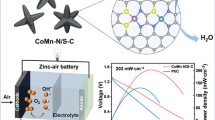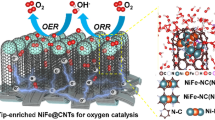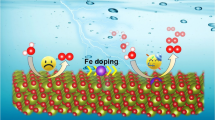Abstract
The design and synthesis of the highly active metal-organic framework (MOF)-based catalysts open new avenues to facilitate the kinetically unfavorable oxygen reduction reaction (ORR). In this paper, we elucidate the design and fabrication of an efficient electrocatalyst with a novel structure for the enhancement of the ORR performance by decorating the surface of the ZIF-8 precursor with ferrocene formic acid, followed by a two-step carbonization process, which is critical for the encapsulation of pyrolytic Fe3C nanoparticles (NPs) into carbon nanotubes (CNTs) and the isolation of Fe single atoms onto an N-doped carbon (NC) matrix. Moreover, the relative Fe content is vital to optimize the ORR performance of the catalysts. The resulting Fe3C@CNT/NC-M catalyst has an optimized structure. It shows great long-term stability and excellent electrocatalytic ORR performance in alkaline solution, with the half-wave potential and limiting current reaching 0.941 V and 6.31 mA cm−2, respectively. Furthermore, the electrocatalyst has a strong tolerance to and good stability in a methanol solution. The Fe3C@CNT/NC-M zinc-air battery delivers a large open-circuit potential of 1.525 V, a peak power density of 348 mW cm−2 at 420 mA cm−2, and a maximum capacity of 843 mA h gZn−1 at 10 mA cm−2. Thus, this synthetic strategy provides a promising pathway toward constructing MOF-based electrocatalytic materials with effective and stable ORR performance.
摘要
高活性MOF基催化剂的设计和合成为促进动力学不利的氧还原 反应(ORR)过程开辟了新的途径. 本研究通过在ZIF-8前驱体表面涂覆 二茂铁甲酸, 然后进行两步炭化工艺, 设计和制备了一种具有新型结构 的高效电催化剂, 以提高ORR性能. 两步炭化过程对于将热解Fe3C纳米 颗粒封装到碳纳米管(CNTs)中以及将Fe单原子隔离到N掺杂碳(NC)基 体上至关重要. 此外, Fe元素的相对含量对优化催化剂的ORR性能至关 重要. 所制得Fe3C@CNTs/NC-M催化剂结构先进, 在碱性溶液中表现出 良好的长期稳定性和电催化ORR性能, 其半波电位和极限电流分别达 到0.941 V和6.31 mA cm−2. 此外, 该电催化剂在甲醇溶液中具有较强的 耐受性和良好的稳定性. Fe3C@CNTs/NC-M锌空气电池(ZAB)具有 1.525 V的开路电位, 420 mA cm−2时的峰值功率密度为348 mW cm−2, 10 mA cm−2时的最大容量为843 mA h gZn−1. 因此, 这种合成策略为构 建具有有效和稳定的ORR性能的MOF基电催化材料提供了一条有效 途径.

Similar content being viewed by others
References
Zhao T, Wu H, Wen X, et al. Recent advances in MOFs/MOF derived nanomaterials toward high-efficiency aqueous zinc ion batteries. Coord Chem Rev, 2022, 468: 214642
Qin X, Kim D, Piao Y. Metal-organic frameworks-derived novel nanostructured electrocatalysts for oxygen evolution reaction. Carbon Energy, 2020, 3: 66–100
Li S, Li E, An X, et al. Transition metal-based catalysts for electrochemical water splitting at high current density: Current status and perspectives. Nanoscale, 2021, 13: 12788–12817
Shen Y, Pan T, Wang L, et al. Programmable logic in metal-organic frameworks for catalysis. Adv Mater, 2021, 33: e2007442
Hu J, Xu Q, Wang X, et al. Charge-transfer-regulated bimetal ferrocene-based organic frameworks for promoting electrocatalytic oxygen evolution. Carbon Energy, 2023, 5: e315
Zhao M, Liu H, Zhang H, et al. A pH-universal ORR catalyst with single-atom iron sites derived from a double-layer MOF for superior flexible quasi-solid-state rechargeable Zn-air batteries. Energy Environ Sci, 2021, 14: 6455–6463
Deng Y, Chi B, Li J, et al. Atomic Fe-doped MOF-derived carbon polyhedrons with high active-center density and ultra-high performance toward PEM fuel cells. Adv Energy Mater, 2019, 9: 1802856
Li Y, Zhang P, Wan L, et al. A general carboxylate-assisted approach to boost the ORR performance of ZIF-derived Fe/N/C catalysts for proton exchange membrane fuel cells. Adv Funct Mater, 2021, 31: 2009645
Li C, Zhang H, Liu M, et al. Recent progress in metal-organic frameworks (MOFs) for electrocatalysis. Ind Chem Mater, 2023, 1: 9–38
Kandambeth S, Kale VS, Fan D, et al. Unveiling chemically robust bimetallic squarate-based metal-organic frameworks for electrocatalytic oxygen evolution reaction. Adv Energy Mater, 2023, 13: 2202964
Pan J, Chen Z, Wang P, et al. The overall water splitting of CdS/Ti3+-SrTiO3 core-shell heterojunction via OER enhancement of MnOx nanoparticles. Chem Eng J, 2021, 424: 130357
Yuan S, Cui L, Dou Z, et al. Nonprecious bimetallic sites coordinated on N-doped carbons with efficient and durable catalytic activity for oxygen reduction. Small, 2020, 16: 2000742
Zhang X, Zhang S, Yang Y, et al. A general method for transition metal single atoms anchored on honeycomb-like nitrogen-doped carbon nanosheets. Adv Mater, 2020, 32: 1906905
Cao L, Li Z, Su K, et al. Rational design of hollow oxygen deficiency-enriched NiFe2O4@N/rGO as bifunctional electrocatalysts for overall water splitting. J Energy Chem, 2021, 54: 595–603
Chen C, Tuo Y, Lu Q, et al. Hierarchical trimetallic Co-Ni-Fe oxides derived from core-shell structured metal-organic frameworks for highly efficient oxygen evolution reaction. Appl Catal B-Environ, 2021, 287: 119953
Jin H, Zhao X, Liang L, et al. Sulfate ions induced concave porous S-N co-doped carbon confined FeCx nanoclusters with Fe-N4 sites for efficient oxygen reduction in alkaline and acid media. Small, 2021, 17: 2101001
Zhang L, Zhu J, Li X, et al. Nurturing the marriages of single atoms with atomic clusters and nanoparticles for better heterogeneous electrocatalysis. Interdisc Mater, 2022, 1: 51–87
Wang Y, Pan Y, Zhu L, et al. Solvent-free assembly of Co/Fe-containing MOFs derived N-doped mesoporous carbon nanosheets for ORR and HER. Carbon, 2019, 146: 671–679
Chen G, Liu P, Liao Z, et al. Zinc-mediated template synthesis of Fe-N-C electrocatalysts with densely accessible Fe-N active sites for efficient oxygen reduction. Adv Mater, 2020, 32: e1907399
Wang C, Lin Y, Cui L, et al. 2D metal-organic frameworks as competent electrocatalysts for water splitting. Small, 2023, 19: e2207342
Jin H, Yu R, Hu C, et al. Size-controlled engineering of cobalt metal catalysts through a coordination effect for oxygen electrocatalysis. Appl Catal B-Environ, 2022, 317: 121766
Zhao X, He X, Chen B, et al. MOFs derived metallic cobalt-zinc oxide@nitrogen-doped carbon/carbon nanotubes as a highly-efficient electrocatalyst for oxygen reduction reaction. Appl Surf Sci, 2019, 487: 1049–1057
Zeng K, Zheng X, Li C, et al. Recent advances in non-noble bifunctional oxygen electrocatalysts toward large-scale production. Adv Funct Mater, 2020, 30: 2000503
Liang X, Xiao J, Weng W, et al. Electrochemical reduction of carbon dioxide and iron oxide in molten salts to Fe/Fe3C modified carbon for electrocatalytic oxygen evolution. Angew Chem Int Ed, 2021, 60: 2120–2124
Zhao Y, Zhang J, Guo X, et al. Fe3C@nitrogen doped CNT arrays aligned on nitrogen functionalized carbon nanofibers as highly efficient catalysts for the oxygen evolution reaction. J Mater Chem A, 2017, 5: 19672–19679
Cao M, Liu Y, Sun K, et al. Coupling Fe3C nanoparticles and N-doping on wood-derived carbon to construct reversible cathode for Zn-air batteries. Small, 2022, 18: 2202014
Yang Q, Liu R, Pan Y, et al. Ultrahigh-loaded Fe single atoms and Fe3C nanoparticle catalysts as air cathodes for high-performance Zn-air batteries. ACS Appl Mater Interfaces, 2023, 15: 5720–5731
Xu W, Yoon D, Yang Y, et al. MOF-derived bimetallic Pd-Co alkaline ORR electrocatalysts. ACS Appl Mater Interfaces, 2022, 14: 44735–44744
Cheng H, Xu G, Zhu C, et al. Porous MOF derived TiO2/ZnO/C@CNTs composites for enhancing lithium storage performance. Chem Eng J, 2023, 454: 140454
Liu X, Wang L, Zhang G, et al. Zinc assisted epitaxial growth of N-doped CNTs-based zeolitic imidazole frameworks derivative for high efficient oxygen reduction reaction in Zn-air battery. Chem Eng J, 2021, 414: 127569
Choi EY, Kim DE, Lee SY, et al. Cobalt nanoparticles-encapsulated holey nitrogen-doped carbon nanotubes for stable and efficient oxygen reduction and evolution reactions in rechargeable Zn-air batteries. Appl Catal B-Environ, 2023, 325: 122386
Luo W, Wang Y, Luo L, et al. Single-atom and bimetallic nanoalloy supported on nanotubes as a bifunctional electrocatalyst for ultrahigh-current-density overall water splitting. ACS Catal, 2022, 12: 1167–1179
Xue J, Deng S, Wang R, et al. Efficient synergistic effect of trimetallic organic frameworks derived as bifunctional catalysis for the rechargeable zinc-air flow battery. Carbon, 2023, 205: 422–434
Li S, Feng C, Xie Y, et al. Synthesis of nitrogen-rich porous carbon nanotubes coated Co nanomaterials as efficient ORR electrocatalysts via MOFs as precursor. J Alloys Compd, 2022, 911: 165060
Srinivas K, Chen X, Liu D, et al. Surface modification of metal-organic frameworks under sublimated iron-atmosphere by controlled carbonization for boosted oxygen evolution reaction. Nano Res, 2022, 15: 5884–5894
Zhang S, Lin C, Ye J, et al. Bi2S3/rGO nanocomposites with covalent heterojunctions as a high-performance aqueous zinc ion battery material. Ceram Int, 2023, 49: 22160–22169
Ruan Q, Feng R, Feng J, et al. High-activity Fe3C as pH-universal electrocatalyst for boosting oxygen reduction reaction and zinc-air battery. Small, 2023, 19: 2300136
Cheng Y, Hu S, Luo G, et al. FeCoN co-doped hollow carbon nanocage grafted with carbon nanotubes as an electrocatalyst for enhanced oxygen reduction reaction. ACS Appl Energy Mater, 2023, 6: 2010–2021
Ferrari AC, Basko DM. Raman spectroscopy as a versatile tool for studying the properties of graphene. Nat Nanotech, 2013, 8: 235–246
Phan TH, Van Gorp H, Li Z, et al. Graphite and graphene fairy circles: A bottom-up approach for the formation of nanocorrals. ACS Nano, 2019, 13: 5559–5571
Greenwood J, Phan TH, Fujita Y, et al. Covalent modification of graphene and graphite using diazonium chemistry: Tunable grafting and nanomanipulation. ACS Nano, 2015, 9: 5520–5535
Li YW, Zhang WJ, Li J, et al. Fe-MOF-derived efficient ORR/OER bifunctional electrocatalyst for rechargeable zinc-air batteries. ACS Appl Mater Interfaces, 2020, 12: 44710–44719
Xie T, Hu J, Xu Q, et al. Metal-organic framework derived Fe3C nanoparticles coupled single-atomic iron for boosting oxygen reduction reaction. J Colloid Interface Sci, 2023, 630: 688–697
Ding J, Guo D, Hu A, et al. Resisting metal aggregation in pyrolysis of MOFs towards high-density metal nanocatalysts for efficient hydrazine assisted hydrogen production. Nano Res, 2023, 16: 6067–6075
Xu C, Guo C, Liu J, et al. Accelerating the oxygen adsorption kinetics to regulate the oxygen reduction catalysis via Fe3C nanoparticles coupled with single Fe-N4 sites. Energy Storage Mater, 2022, 51: 149–158
Acknowledgements
This work was supported by Anhui Provincial Natural Science Foundation (1908085J10), the National Natural Science Foundation of China (21671004), the Institute of Energy, Hefei Comprehensive National Science Center (21KZS216), and the Scientific Research Foundation for High-level Talents of Anhui University of Science and Technology (2022yjrc50).
Author information
Authors and Affiliations
Contributions
Author contributions Wang C performed experiments, analyzed data and wrote the original draft. Hu J carried out the administration of the project and provided supervision, review and editing of the paper. Li Z provided supervision, review and editing. Mertens SFL analyzed the data and revised the paper. Lei J and Li S performed data analysis. All authors contributed to the general discussion.
Corresponding authors
Ethics declarations
Conflict of interest The authors declare that they have no conflict of interest.
Additional information
Supplementary information Experimental details and supporting data are available in the online version of the paper.
Cuiping Wang is a graduate student at the School of Chemical Engineering, Anhui University of Science and Technology (AUST). Her main research interest is the application of MOF materials and their derivatives in electrochemistry.
Zhi Li received a PhD degree in 2017 from the Department of Chemistry of KU Leuven under the supervision of Prof. Steven De Feyter and Prof. Stijn F. L. Mertens. Afterward, he joined Nanjing University as a postdoctoral fellow in 2019. He joined AUST in 2022 with research interests including the functionalization of 2D materials and electrocatalytic processes.
Stijn F. L. Mertens is a Professor of physical electrochemistry at Lancaster University, UK. He obtained a PhD degree in chemistry from Ghent University, Belgium, and a Habilitation in chemical physics from Vienna University of Technology, Austria. His research interests include in situ and in operando studies of well-defined electrochemical interfaces towards an atomic-scale understanding of catalysis, molecular self-assembly and single-molecule switching.
Jinsong Hu received his PhD degree in 2011. Then, he worked at AUST. After a postdoctoral career at AUST from November 2015 to August 2017, he began independent research as a Professor at AUST. His research interests include fluorescent sensors based on MOFs and MOFs-based nanomaterials.
Electronic Supplementary Material
Rights and permissions
About this article
Cite this article
Wang, C., Li, Z., Lei, J. et al. Nitrogen-carbon-encapsulated Fe3C nanoparticles as highly efficient earth-abundant oxygen reduction electrocatalysts. Sci. China Mater. 67, 762–770 (2024). https://doi.org/10.1007/s40843-023-2768-3
Received:
Accepted:
Published:
Issue Date:
DOI: https://doi.org/10.1007/s40843-023-2768-3




